#New Mexico bootheel
Text

New Mexico bootheel
4 notes
·
View notes
Text
Climate of Missouri

See Weather Forecast for Missouri today: https://weatherusa.app/missouri
See more: https://weatherusa.app/zip-code/weather-63369
https://edition.cnn.com/2024/05/05/weather/texas-rivers-flooding-rain-forecast/index.html
Missouri's geography varies widely across the state. North of the Missouri River, the land is gently rolling with fertile plains and well-watered prairie country, reflecting its glacial history. South of the river lies the Ozark Mountains, dominating a large portion of the state's landscape. With the exception of the extreme southeastern corner, including the Bootheel, and areas along the western boundary, this region is characterized by rough and hilly terrain, deep valleys, swift streams, and abundant caves and natural springs. Elevations range from 1,000 to 1,400 feet (300 to 425 meters) above sea level, although near the western border, elevations rarely exceed 800 feet (250 meters). Taum Sauk Mountain, located about 90 miles (145 km) south of St. Louis, stands as the state's highest point, reaching 1,772 feet (540 meters) above sea level. In far southeastern Missouri, a part of the alluvial plain of the Mississippi River features elevations below 500 feet (150 meters). Near the southwestern edge of this region lies the state's lowest point, where the St. Francis River flows into Arkansas at an elevation of approximately 230 feet (70 meters).
See more: https://weatherusa.app/zip-code/weather-63041
https://weatherusa.app/zip-code/weather-63043
https://weatherusa.app/zip-code/weather-63071
https://weatherusa.app/zip-code/weather-63077
The St. Francois Mountains in the eastern Ozarks are characterized by igneous granite and rhyolite outcroppings, adding a unique geological feature to Missouri's landscape. In contrast, the remainder of the state is primarily underlain by sedimentary rocks, including limestones, dolomites, sandstone, and shale.
Missouri is generally considered tectonically stable, with only occasional small earth tremors occurring, particularly in the southeastern portion of the state. However, there remains a possibility of another devastating earthquake similar to those centered at New Madrid in 1811–12. While the likelihood of such an event is uncertain, the potential impact underscores the importance of ongoing monitoring and preparedness efforts in the region.
Missouri's diverse geography and soil conditions facilitate farming across all its counties, although the Ozark Mountain region primarily supports livestock and poultry farming due to its thin soil. The northern part of the state benefits from rich glacial and loessial soils, contributing to its agricultural productivity. Additionally, the extensive alluvial soils in the bottomlands along rivers and streams further enhance farming potential in Missouri. The Missouri River, which drains most of the state, plays a significant role in its drainage system.
Artificial lakes, created by damming rivers and streams, are a notable feature of Missouri's landscape. The Lake of the Ozarks, formed by the Bagnell Dam on the Osage River, stands out as one of the largest man-made lakes in the country, offering both hydroelectric power generation and recreational opportunities.
Missouri's climate is influenced by a combination of cold Canadian air, warm Gulf of Mexico air, and drier southwest air. Summer winds typically blow from the south and southwest, while winter winds originate from the north and northwest. Precipitation, crucial for crops, varies across the state, ranging from around 35 inches (890 mm) in the north to nearly 50 inches (1,270 mm) in the extreme southeast. Missouri experiences about 25 tornadoes annually on average, owing to its location on the edge of Tornado Alley.
See more: https://weatherusa.app/zip-code/weather-63117
https://weatherusa.app/zip-code/weather-63344
https://weatherusa.app/zip-code/weather-63369
In terms of plant and animal life, Missouri boasts a diverse range of flora and fauna. While forests cover about one-third of the state, much of the original prairie land has been converted for cultivation. Nonetheless, efforts by governmental and nongovernmental organizations have preserved scattered prairie remnants. Missouri's state parks harbor numerous plant and animal species, including over 100 species of fish, 200 species of birds, and various mammals. Historically, large animals like elk, deer, bison, and bears were abundant, but their populations declined due to European settlement and agricultural expansion. However, conservation efforts, such as restocking programs, have led to the recovery of certain species, including deer, which now number close to a million in the state. Additionally, Missouri is home to a small population of bears that migrated from Arkansas, although hunting them is prohibited.
See more: https://weatherusa.app/zip-code/weather-63770
https://weatherusa.app/zip-code/weather-63739
0 notes
Text
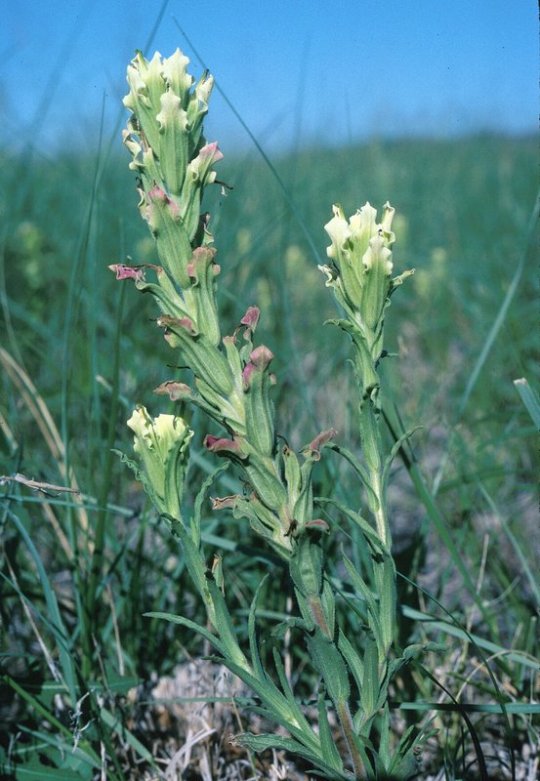
Swale paintbrush. photo by Mark Egger, WTU Herbarium
SILVER CITY, N.M.— Following a lawsuit by the Center for Biological Diversity, the U.S. Fish and Wildlife Service today proposed to protect the swale paintbrush as an endangered species. The 19-inch-tall, yellowish-reddish flower is known to exist in only a single location in southwestern New Mexico’s bootheel.
“This is great news for these graceful, stately plants and for everyone who cares about the natural world,” said Michael Robinson, senior conservation advocate at the Center. “The Endangered Species Act has prevented the extinction of so many other plant and animal species. In this instance, the law will help save a unique flower that’s part of what makes the Southwest not only botanically interesting but also beautiful.”
The swale paintbrush once lived in another location in the bootheel and in 11 spots in the Mexican states of Chihuahua and Durango. But there is no information that it survives in these previously identified habitats. It was last confirmed in Mexico in 1985.
In addition to its extremely limited known distribution, the swale paintbrush is imperiled by drought from global warming and from potential trampling by livestock.
Once protections are finalized the Service will develop a recovery plan for the plants. That plan will likely call for reintroducing the swale paintbrush to other habitats to ensure the species survives in case its current known population is wiped out.
1 note
·
View note
Text










Las Cruces District BLM, New Mexico.
It was raining in the morning, but I shouted "Hurumph!" at the world and headed out anyway. It was still raining as I started, but it finished up after a while. The wind didn't finish up for a long while more. Had I let the weather turn me away, I'd have missed these pillared hills and the grand view from the top of Coyote Peak.
#Continental Divide Trail#Great Divide#nature#hiking#Las Cruces BLM#New Mexico#landscape#day hike#travel#mountains#outside#New Mexico bootheel#bootheel#hike#peak bagging#peakbagger#CDT#Coyote Peak#Coyote Hills
9 notes
·
View notes
Text
New Mexico, part 1: Border to Lordsburg
Journaling about walking in the desert on the Continental Divide Trail, under read more for courtesy (don’t say I never did nothing for ya).
Day 1
Mileage: ~8 miles
It’s hotter than hell in the New Mexico bootheel, so hot that when you pray to God all you’re likely to hear is distant heavenly laughter. On your own, kiddo.
The CDTC shuttle drops four of us off around 9:30 am at the southern terminus, 10 feet away from the Mexican border. It’s a rough road into the terminus monument and riding shotgun, I barely keep my stomach where it belongs. We take a group picture at the monument, chitchat with some southbound hikers who just finished, and say goodbye to the shuttle driver’s dog Cookie. I’m the second one to step out onto the trail, and within 50 paces I’m hurling in the dirt. Car sickness catching up with me after all. I finish upchucking, kick some sand over the evidence, and keep it trucking. Pretty sure nobody saw. I better not end up getting a trail name based off my bright orange puke (sweet potato fries, you betray me).
I walk with a guy from Seattle named Blue Steel for awhile and we make decent conversation, but part ways when I stop for a couple minutes to mix some electrolyte powder in one of my water bottles, in hopes of counteracting the epic puke fest from earlier.
The day drags on towards noon and gets even hotter. The sun beats down. It’s all cactuses and creosote and the occasional prickly alien-looking ocotillo, almost no shade to be found. I watch Blue Steel’s shiny reflective hiking umbrella and bright blue backpack (name origin? need to remember to ask about this if I ever catch up to him) bob up ahead. About 5 miles in I find myself crouching and dry heaving by the side of the trail, and I make an executive decision to find what shade I can and wait out the high noon heat.
Slithering down into a dry wash and under a creosote? mesquite? tree that grants sparse shade, I feel like shit. I throw my sleeping pad down onto a patch of shade just big enough for me to fit in curled up, and promptly crawl away to puke. On hands and knees under the blazing sun, watching my watery vomit (pink this time, from the Pedialyte powder) trickle into the sand. I crawl back to my sleeping pad and lay on my belly, head on my arms, and puke some more until I’m just dry heaving. The sand sucks up my hurl, any liquid it can get. Lesson one for me: you can’t afford to be picky out here.
My head pounds. This could be very, very bad. I think back to my EMT and Wilderness First Responder classes. Heat exhaustion can lead to heat stroke, which will kill you by cooking your brain inside your skull and denaturing the proteins in your body. Was vomiting a sign of heat exhaustion? I’m pretty sure it is. Then again, I was sick to my stomach last night, and this morning on the shuttle ride in. I assumed it was nerves and car sickness respectively, but maybe I caught a stomach bug somewhere. Still very, very bad — puking is dehydrating as it is, and with the sweating I’ve been doing and the scarcity of water out here, I can’t afford to waste fluids by splattering them on my sneakers. The mantra I learned as an 8 year old pops into my head — 3 weeks without food, 3 days without water. If I can’t keep enough water down to stay hydrated, and if I can’t get well enough to walk to the next water, this could kill me.
I pull myself together enough to drape my tent fly over the branches above me, adding a little extra shade. I take a few cautious sips of water and almost immediately bring them back up. Motherfucker. It’s 8.6 miles to the access road and the first water cache. The shuttle driver will be back tomorrow morning. I can hitch a ride with him back to town, I just have to keep it together until dusk, when it’ll be cool enough to start walking again. With nothing else to do, I doze fitfully in the heat.
I wake up around 2 pm, sweaty and sticky. I force myself to get up to take a leak. I expect to hurl again from the motion as I stand up, but I actually feel okay. Hallelujah.
Returning to my sleeping pad and curling up to read a book on my phone, I still feel okay. I make myself drink a tiny sip of water and immediately get nauseous, but I decide that even if it comes up, I’ll just swallow that motherfucker right back down. Like the dirt, I can’t afford to be picky. After 10 minutes I’m okay, so I take another sip and go back to my book. 10 minutes later, another. And on like this until 4 pm. No upchuck yet. It’s even starting to feel a little cooler outside. Glory be, yadda yadda. I might make it through this without running back to town with my tail between my legs.
A lone vulture soars overhead. I say fuck you pal in my best Brooklyn dockworker voice, but the bird doesn’t seem to be here for me anyways.
I haul myself out of the wash at 7:30 pm, after keeping down 2 liters of water and even some food. The sun is going down. The air is cool and the walking’s easy, powered by the high of knowing I can be killed, only not today. The lights of Mexico behind me, Orion’s Belt above me, and a good solid trail under my feet.
Day 2
Mileage: 19 mi
I walked by headlamp for a few hours last night, then cowboy camped after getting too tired to navigate. Up at 5 am and walking. I make it to the first water cache and fill my bottles. The couple who started with me, Rachel and Rainbird, are there too and throughout the day we leapfrog past each other.
I’d been planning to sleep early in a shady wash I saw on the drive in, but I make it there at 9 am. The day’s still young and I don’t want to lay down and sleep now. I want to make it off this roadwalking section, which means I have 10 miles still to go. And I need to do at least 20 miles a day to make it back to Lordsburg in 4 days. I keep walking.
Around eleven the heat is intense. I should be going to ground right about now, but there’s no shade to be found. At least I’m not nauseous. I keep walking.
12:30 — I sit down to put on sunscreen and tape the blisters on my feet. The next water cache is only a mile away, but a comment on Farout says there’s no shade there until 4 miles later, under a tree that’s up a hill. The sun beats down. Highs of 92 today. The heat’s only going to get worse the rest of the afternoon. 5 more miles of totally exposed walking is not going to do anything good for me. Christ, just one patch of shade.
I keep walking. About a quarter mile off the trail is a stand of promisingly big acacia trees. The ground is covered in thorny plants and dry cow pies, but under one tree is just enough bare dirt for me to lay in. I hang my tent fly over the branches to give the tree’s sparse shade a hand. It’s still hotter than hell, but at least I’m not hurling and at least the cow pies don’t smell. I drink my gross electrolytes (orange this time!) and wait for dusk to come.
Haven’t been eating much, which is maybe a little concerning. I think the heat messes with my appetite. Walking at night, I actually got hungry and sat down a couple times for a snack. Still, not enough calories in for the work I’ve been doing.
5:40 pm. Had to move spots with the sun. Circled around to the other side of the tree when my phone briefly quit holding a charge from the heat. I used to think I didn’t get lonely but now I know that’s not true, and also being lonely sucks. I miss my dad and I miss sleeping in the car while he drove, and I hate that I have to be a grownup and deal with my own shit. It’s hot out here and I’m scared and I’m trying to be tough, but I just want my dad to come pick me up and give me a hug and tell me it’s okay. Probably I’m tired and hungry right now and that’s why this is happening in my brain, but I just want a hug. I don’t want to be alone in the desert anymore. I want to be safe and held and not have to worry about anything. I finally fall asleep, fitfully for an hour or so.
Leave the shade tree around 8 pm. The sun’s going down. I sob most of the way to the second water cache, so hard it brings me to my knees in the dirt. I miss my dad.
Make camp sooner than I’d planned. I’m tired, bone-deep emotional exhaustion that usually comes from being hungry or sleep deprived. I decide to set up my tent instead of cowboy camping, which adds at least a half hour to the bedtime process. The sand is too shallow to set any stakes, so I guy-line everything instead. I prefer cowboy camping, especially when the weather’s beautiful like now, but it’s this tent’s maiden voyage and I figure I should get adept at setting it up before I have to do it in the rain.
With the tent set up, I crawl inside, strip down to my boxers, and shovel food into my mouth while horizontal.
Day 3
Mileage: 22 mi
I’m on the trail again later than I should be, around 7. It’s about 15 miles to the shade tree I’m aiming for, so I’ll be racing the sun today.
After packing up my tent, I take a second to wash my face of the epic amounts of blood crusted on from the nosebleed I had in the middle of the night. I took some ibuprofen yesterday for the blisters, so that combined with the dry air probably caused the nosebleed. My feet feel a lot better, though. I was barefoot in my tent all last night, which I think helped ease the blisters. I retaped them before setting out today anyways.
The heat doesn’t bother me too much today. Either I’m better hydrated or I’m getting acclimated. Probably both.
I see a snake laying on the trail, and am jumping away from it before my brain has even processed what it is. Like a horse with a garden hose. I haven’t lived in a place with dangerous snakes since I was 6 years old, but somewhere in the back of my brain, evolution has hardwired SNAKE BAD SCARY into me. Guess I’m a descendant of people who didn’t get killed by snakebites. Sweet.
There’s trail magic near a junction, under a big shady tree. Gatorade in a cooler (the ice is melted into water, but the drinks are still cold!), fun-sized candy, and gallons on gallons of water. I sit under the tree in the wind and shade and feel good.
I don’t quite make it to the siesta tree I was aiming for, but by 2 pm I’ve done 14 miles, the sun’s getting too hot, and FarOut says there’s 3.8 miles still to go to that particular tree. I settle in under a different tree next to a wide dry wash.
An hour later, I notice there’s a snake coiled around the base of the tree. I pack up my shit and set off to find a different tree.
I leave my second siesta tree at 6, having had a pretty ungood siesta. Too hot, not enough shade. Slept for about an hour, which did something weird to my contacts. My vision’s blurry and it takes me a half hour to find the trail again.
The sun is setting as I crest a ridge. Pink and orange, and I start to cry again. I miss my dad. I miss my mama and I wish she were still alive. I miss my little brother and I wish I’d been there for him these last few years. I sit down right there on the trail and sob while eating Oreos. I can’t remember the last time I cried like this, let alone the last time I cried twice in two days.
It occurs to me that between the nosebleed, the walking in the heat, and my apparently regularly scheduled sunset sobbing, I’ve already poured the trifecta of blood, sweat, and tears into this trail.
The Oreos help. I think I was hungry. With my blood sugar raised, I keep walking into the night. The stars come out and I make Cache 3. Fresh water, hallelujah. I aim to do 5 more miles before bed, but that doesn’t happen. I’m very tired and my feet are starting to hurt in a way that’s less blister, more tendon twinges. I’m in trouble if I fuck up my feet, so I spend a frustrating 20 minutes putting my tent up in the wind. (I think about giving up and cowboy camping, but I’ve seen a whole lot of bigass spiders around this section and if I wake up to a huge hairy spider crawling on me I may simply never recover.) Once it’s up, it’s surprisingly solid for a structure supported by trekking poles in high gusts, but Jesus H., getting it set up in those conditions is the worst.
In bed, finally. Contacts out, clothes off, feet sore, still munching on my Oreos. Exhausted. Time to sleep. Goodnight.
Day 4
Mileage: 20 miles
I sleep in a little, waking up at 6 instead of 5. I figure I’ll do 10 miles in the day and then 10 miles at night. That’ll leave me with 16 miles to get to town tomorrow. Really my goal is to find any decent siesta tree so I can take a real good nap.
Once I work the soreness out, the walking’s easy. There’s a strong breeze and I’m in a good mood. The backs of my legs get covered in the dust I kick up.
The tendon twinge comes back eventually. It’s symmetrical on both sides, running on the outside of the bridge, back along the heel, and up to the calf. My blisters are symmetrical too — on the ball of my foot right below my big toe and second toe, and one on the side of each second toe. I wonder if I’m compensating for the blister pain by walking differently, thus fucking up other parts of my feet. I start walking on the blisters deliberately, which on the bright side distracts me from every other pain in my body.
I get to a siesta tree about 10 miles in, around 1 pm, and promptly have another, bigger nosebleed. I now have blood spattered all over me, which is a little gross but makes me feel kinda cool. It’s a good tree, here. No snakes. Some kind of small skull laying in the sand, though. I listen to Jeff Davis County Blues on repeat with my hat over my eyes.
At 5:30 I’m off and walking again. I make the next water cache in half an hour and cross the highway. The wild grass is pale and glowing, the sun burning low in the sky. The powerlines look like crosses.
I find scattered pile after pile of cattle bones, which is cool but a little unnerving. Seeing all the sunbleached bones everywhere is like a constant reminder of the desert’s ruthlessness. In sixty miles I haven’t seen a single natural source of water. There are water caches for hikers, and solar wells for cattle (that hikers also use), and that’s it. You make it through this with human-made ingenuity and the grace of the desert alone. It’s frightening, and peaceful at the same time.
Right when the sun goes down, I start feeling a sunburn I got on the backs of my calves earlier. It’s bad, so bad that it hurts to walk. I roll up my pant legs to keep friction off the burns, take probably too much ibuprofen, and keep going. The night is cool and I feel okay.
I walk until 11 pm, when the trail meanders listlessly across cow paths and open fields with almost no signage, and I’m too tired to keep finding the path. I set up my tent in record time and toss and turn trying to find a position that doesn’t hurt my sunburned legs. Another nosebleed. Town tomorrow.
Day 5
Mileage: 17 miles
Slept good last night, despite the pain. I’m determined to make it to town tonight come hell or high water. My legs don’t even hurt that bad anymore, but I take a couple ibuprofen preemptively for the swelling.
Midday finds me in a valley with shady junipers and oaks every few miles, an old tractor parked up by the side of the trail, and a solar well with clean flowing water in the middle of a cattle pen. I fill up my bottles and pass Rachel and Rainbird, rearranging their stuff in the shade of the tractor.
I’ve decided to walk through the heat of the day in order to get to town in time to get a room, so I’m drinking water and pounding electrolytes like nobody’s business. It’s not too bad — it’s probably only in the high 80s, and windy too. The thought of A/C and the world’s biggest beef burrito push me forward.
I make the final water cache around noon, then push up the final hill (really more like eight rolling hills that get progressively higher) while singing old country songs to myself. Is anybody goin’ to San Antone…
Some of my older blisters have gone down, but I have new ones on my heels now, and one of them pops in my sock a few miles out of town. I stop for a break and tape up my feet, sitting in the sun on top a hill. I can see the big rigs flying down the highway below, right through town.
I make the final push and get in right around 5, walking down past sheetmetal trailers, old square body Chevys and fifth-gen Fords, all in shades of oranges and pinks. Sunbleached roofs and heat waves coming off the asphalt. I thank the desert for letting me pass.
I get a motel room, flop down on the bed, call my girlfriend and then my dad. Later I walk to the Mexican place next door and emerge triumphant with TWO beef burritos. I eat, take a shower, wash my clothes in the sink, and fall asleep with the TV on. Bliss.
I’ll take a zero day tomorrow (stay in town, no hiking) to do some errands, let my feet heal up, and figure out where I’m going next. And also probably watch a lot of reruns on TV. It feels good to be drifting on the move again.
12 notes
·
View notes
Photo

This is #AntelopeSprings #BorderCrossing, one of a few in #NewMexico and this one is in the #Bootheel! You can see @realdonaldtrump’s ugly border wall/fence in the background. It didn’t do much for “border security” and I’m of the belief that all walls should come down especially anything that represents #colonialborders! The fact is this is original Native Land and still is still under #IllegalOccupation by the illegitimately fake United States. Now that you understand that I’m decolonized, indigenized, and pro-truth how could you ever expect me to support such an abomination like the #SouthernBorder? Don’t try to debate me on this; you’ll never persuade me to prop up the biggest Empire of Lies to ever plague Humanity! (at Antelope Springs, New Mexico) https://www.instagram.com/p/CRmFf5jL1yg/?utm_medium=tumblr
4 notes
·
View notes
Text
It’s hot out today, but then again- the Gorge never really dips below 95 degrees on a good one. She frowns quietly, rolling her sleeves up further- grabbing the next set of tools she needs to finish up the repairs on Pipes. Omnic upgrades and repairs wasn’t something she ever saw herself needing when she decided this schtick, especially with Jesse’s ability at turning a wrench and making just about any damn thing working.
But, necessity is the mother of invention- and all that bullshit.
She’s learned to make do, these past few years.
Kicking her bootheel up and rubbing out the end of the cigarette- the butt only half finished and put aside for later. She isn’t too proud to get out here and work with the others, not when they all need the other to survive.
S’what family does, after all.
“Alright, Pipes. You’re good t’go.”
A couple of slaps to his shoulder as she eases back, sliding the panel into place. A self-satisfied grin as he begins to move more smoothly than before. It’s small victories like these that make her feel vindicated- like they’re something more than just a shit-heel gang out of nowhere, New Mexico.
A real family, just like she’s always wanted.
2 notes
·
View notes
Link
Excerpt from this article published by The Hill:
Two years ago, along the southern border west of El Paso, a Mexican gray wolf loped north through the Chihuahuan Desert and into the United States. A few days later, unable to find a mate, he returned to Mexico.
Today, an 18-foot-high steel barrier could block his path. Sections of President Trump’s border wall built in recent weeks slice through 20 miles of this remote New Mexico desert, where a creature’s ability to traverse vast distances can be a matter of life and death.
Mexican wolves are one of the most endangered mammals on the continent, with just 114 in New Mexico and Arizona and a few dozen across the border in Sonora, Mexico. With a narrow gene pool, their long-term survival may hinge on crossing the border to find mates, just as they did for thousands of years.
Wolves are hardly the only wildlife threatened by the border wall. The new bollard-style barriers in New Mexico also obstruct the movements of kit foxes, cougars and ringtail cats. The walls fragment their populations and increase the risks of inbreeding.
That’s why the border “fence” vs. border “wall” debate simmering in Washington, D.C., during the government shutdown vexes anyone who’s seen a border wall up close. It’s a distinction without a difference. They’re the same thing.
A fine example of where animals still roam freely is the bootheel of southwestern New Mexico, one of the most unvisited landscapes in North America. It’s hot, steep and dry. It’s also a richly biodiverse landscape.
A herd of wild bison wanders the playa valleys. Thousands of feet above, the only descendants of New Mexico’s original desert bighorn sheep patrol the edges of limestone cliffs. The bison and the bighorn sometimes cross the international border for grass and water.
To the west, a single jaguar prowls southern Arizona, a migrant from Sonora. Jaguars evolved in North America before extending their range south to the tropics, only to be wiped out in their original range. Their ancient bones have been found in Nebraska, Tennessee and Florida, among other states. A federal trapper killed the last resident jaguar in January 1964 in Arizona, about 150 miles from the border.In the decades since, several male jaguars have made it to the U.S. from Mexico. If a female appears, they could breed here and genetically bolster the declining jaguars in Mexico. Every inch of new border wall makes that less likely.
Science and reason have a hard time breaking through the twisted politics of the Trump administration. But the facts are irrefutable: Borderland wildlife will pay a terrible price if more walls are erected.
7 notes
·
View notes
Text
Rocky Mountain High
Bayfield, CO
We’ve slowed down on stopping to take pictures of every wow moment, this being our 4th or 5th trip to Colorado and the New Mexico region, but not on repeating WOW! to one another. Our house-sit to Bayfield, Colorado was the best yet in terms of comfortable, clean home, easy pets, and centricity to hikes and sightseeing. We missed being able to watch their horses. They were pastured at a neighbor’s, saving us the hassle of seeing to them. Grrrr!
We hiked a mountain creek during pour-off in New Mexico before we ever reached our destination. In a very quaint and picturesque cemetery in Cimaron, New Mexico, there was a marker stating that the inhabitant, a preacher, was assassinated in 1875. Being a large monument, I trust he was respected.
Our first day in Colorado, we drove to a true ghost town, Pagosa Junction. Being in the Ute Indian land probably accounted for its unmolested condition – not even any graffiti! We were respectful. The route also took us to the community of Allison, giving us a couple abandoned churches to add to our collection.

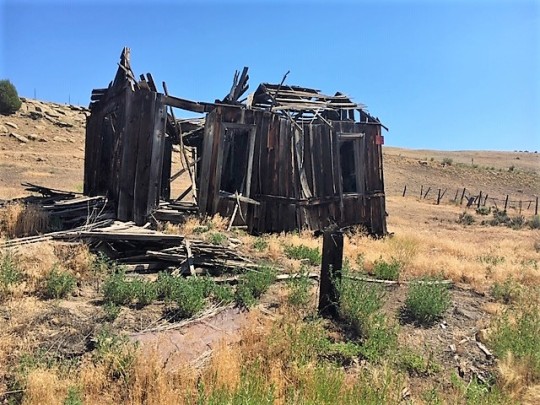



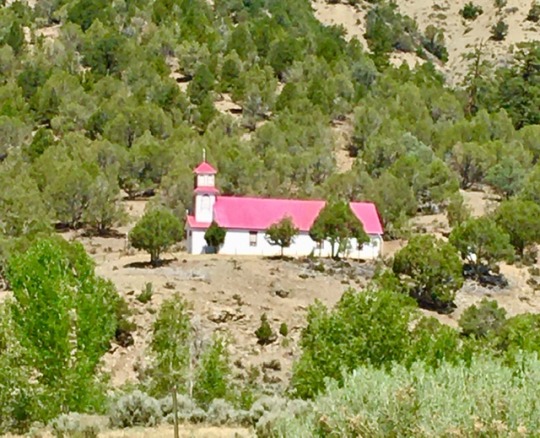
Our last Colorado trip was to Gypsum with two major fires not only consuming nearby forests but smoking the place up and restricting us from several travel experiences. This house-sit in Bayfield, we received extensive instructions regarding potential evacuation in the event of a new fire: move 5 vehicles to designated area, watch for neighbors and relatives to come get vehicles and equipment, crate up the pets (expect resistance), make phone calls, meet at … blah, blah, blah. It’s a 42-acre horse ranch at the 7000’ elevation mark in a pine forest.
The biggest difference among our several house-sits in Colorado was the heat wave in place when we arrived in Bayfield. Yikes, it’s famously fabled that drier and higher air is more comfortable even when the thermometer spikes, but that’s just not true, folks, and I wonder who started that vicious rumor! This high-elevation, dry heat envelops, melts and assaults. But in the early morning before the day of 99 degrees, the temp was in the 50s! Good luck with your wardrobe, travelers!
On the Continental Divide Trail: “It’s perfect weather for a hike,” Wayne said as they neared the 11,000 feet elevation mark. “I’d like it to be 5 degrees warmer,” Debbie replied. Wisely, Wayne said nothing. We let three male hikers pass us. The two younger ones were carrying openly. We wondered if they were taking the third, an oldster out to shoot him. Wayne, unwisely, piped up, “You never know when you might wanna shoot somebody.”
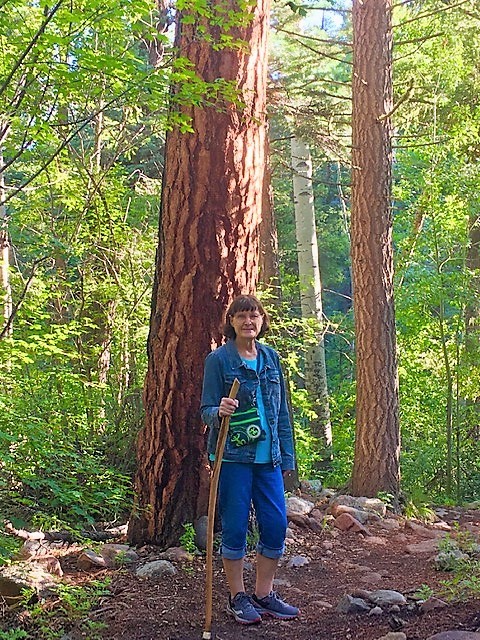

And speaking of graves and cemeteries, one of our eccentricities, we found where Bob Ford was buried. Yup, the Robert Ford. Recall in past blogs we found Clifton Clowers’ grave on Wolverton Mountain, William Bonnie at Ft Sumner, Kit Carson in Sante Fe, Buster Brown/Tom Thumb in the Missouri bootheel, and Absalom Fowler in the locally famous Holly Cemetery in Little Rock. And of course, we’ve been to JFK’s eternal flame in Arlington as well as Abraham Lincoln’s tomb in Springfield, Illinois. But even after all our graveyard treks, we still don’t know who’s in Grant’s tomb. Oh, and Bob Ford? “Well that dirty little coward,” (to the tune of ??) “that shot Mister Howard, he done laid poor Jesse in his grave.”
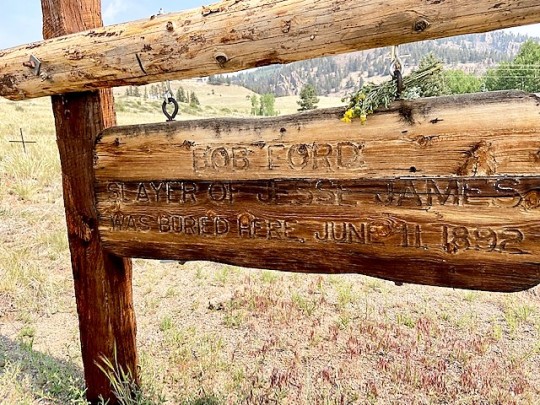
Crossbucks are a “thing” out in the wild wild west. Every style, from humble to grandiose.





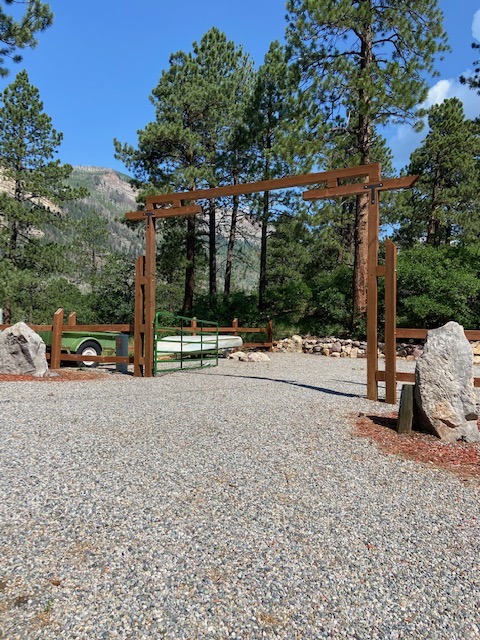
Creede, Colorado, a town named after a man who bought the right, was a mining town that survived the ore: silver, copper, lead, zinc, amethyst. Bat Masterson was a deputy for a bit there. Returning to modern times, the move The Lone Ranger was filmed, in part, in Creede, particularly the train scenes. At the start of the Bachelor Loop, a drive through the mining region, you pass the local fire department where they park their vehicles inside the mountain in old mines. The cavities are huge. The ghost town of Bachelor, the city in the clouds, where over a thousand people lived is but an empty meadow, the remains of one lone fallen-down building at the forest’s edge. There’s a plaque with a photograph of the once-upon-a-town. Amazing that it’s just gone, as are so many of the west’s ghost towns. Some exist only as residential neighborhoods, the town no longer to be. Some, like Peppersauce in Calico Rock, Arkansas, are completely surrounded by the new town, the old abandoned structures still in place.

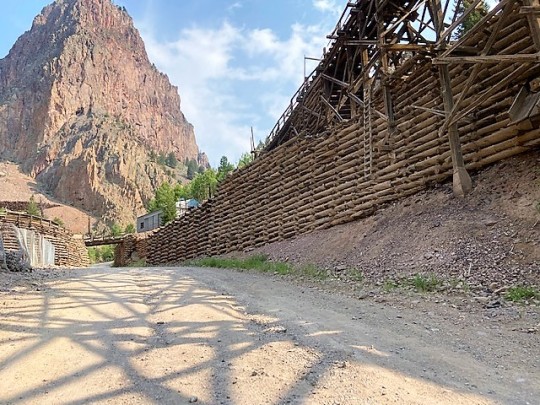


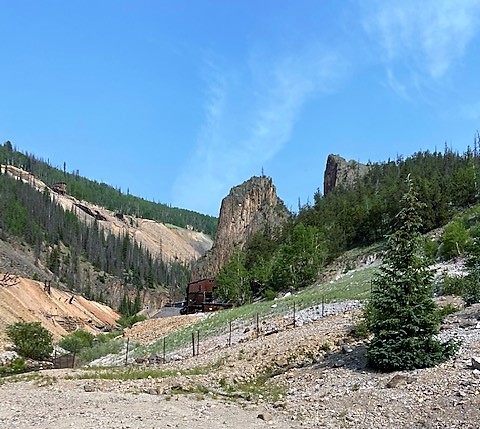
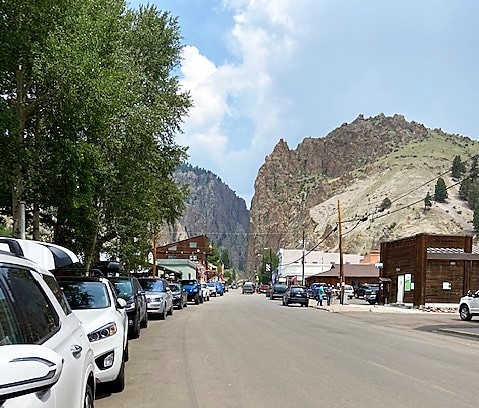

Silverton and Ouray were just as fun as our last trip there, though not as picturesque due to the smoky sky, the result of fires further west, California, Idaho, Oregon. What we do know for sure is that it appears that Texans have annexed the Rockies, but who can blame them? (besides Wayne)


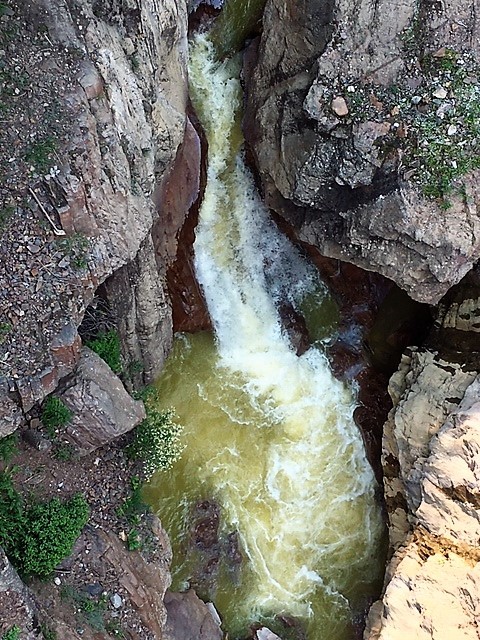

The Four Corners Monument is controlled by the Navajo Indian Nation, since it’s on their land. Covid-19 restrictions limit visitors to 50% capacity causing an hour, or longer, wait. Wayne’s been there, Debbie not, but since both have been all around it, we opted to pass on standing on the exact dot at the cost of $20 per car after a 2-hour drive. A modern, more sophisticated survey would prob’ly move it a mile or so anyway.
We hiked the Colorado Trail, well, part of it, enough to have enjoyed it a lot. The views were, of course, fabulous.

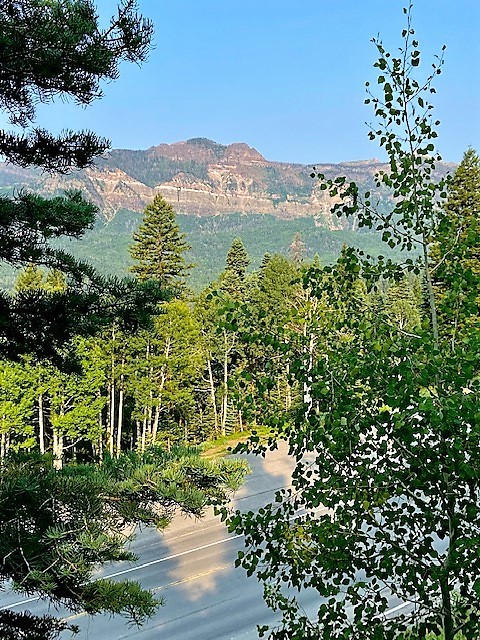

On a second trip to Silverton, with much better visibility due to recent rain and the Oregon/Idaho/California fires smoke blown on a different course, we travelled to Eureka, another ghost town where there were huge mining operations. The Animas River is beautiful, as well as the many streams feeding it. I have to wonder, though, how clean they were during the peak of the mining days. Environmental concerns were decades in the future.



Walking the dog Zoey on the property (42 acres of pasture and pine), a flock of wild turkeys made their way up the hillside not fifty feet from us. They seemed half again larger than the Arkansas wild turkeys. The squirrels appear different than Arkansas red fox or grays. These are sort of mottled with a silverish belt around their neck area. And I don’t believe I’ve ever seen an Arkansas squirrel sit/stand erect like a ground hog. Research indicates it may be a ground squirrel.
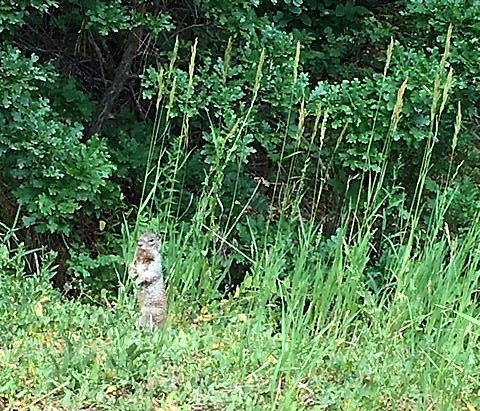
We found a really exciting, back-of-the-mountain road, two actually, that led through ghost towns, naturally. Colorado is truly wondrous, especially when you can get away from the tourists, a difficult process in mid-July.

We found a hole-in-the-wall restaurant, one of our favorite travelling pleasures. The Blue Sky Café in Bayfield. Not being able to decide among the foo-foo descriptions, Wayne settled on a hamburger and sweet potato tots. They were AMAZING! Telling the waitress brought the owner/cook to us – she whispered that she added a mild cajun seasoning. Never had any like it. Their breakfast menu extremely enticing, we were there the next morning at their posted opening time. Nope – a brand new handwritten notice stated that they would be closed on Saturdays. Disappointed, we slunk back to the house for bowls of cereal.
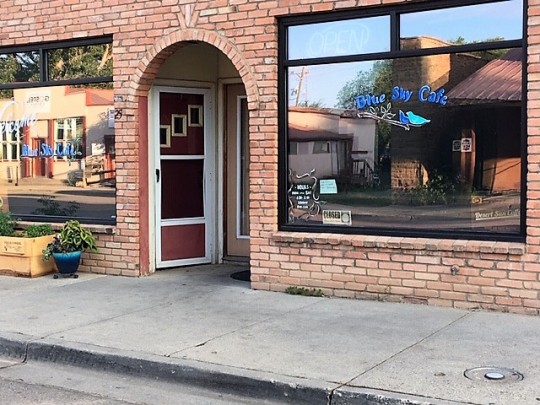
Thus ended our most recent foray into a beloved area of the country. I cannot imagine tiring of this land of exceptional beauty. It’s the eye-candy state!
More Pix:


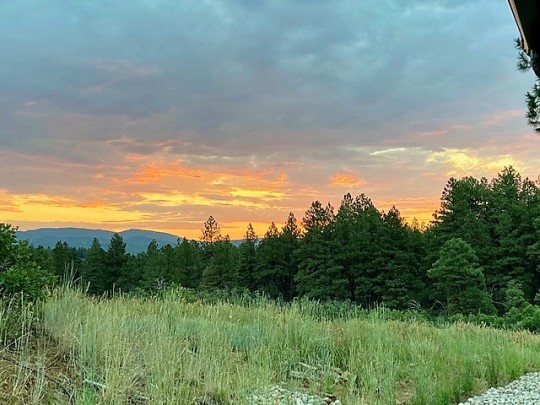


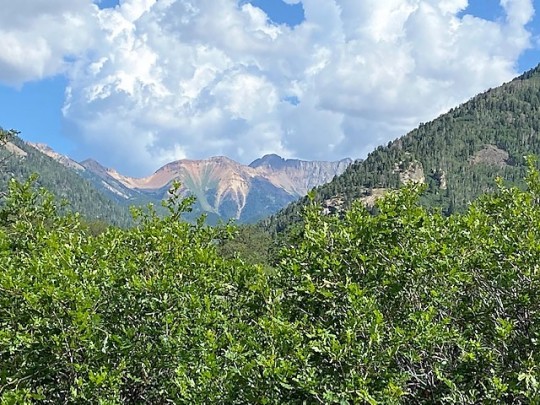
1 note
·
View note
Photo

01/24: from Bisbee we drove southeast to the border town of Douglas, AZ. If you take 15th St in Douglas to the east, the road just keeps going, all the way over the mountains into the “bootheel” of New Mexico
0 notes
Text
Border patrol agent found dead while patrolling New Mexico trail
Border patrol agent found dead while patrolling New Mexico trail
[ad_1]

A first-year US Border Patrol agent was found dead while on patrol of a remote New Mexico trail, officials said.
Border Patrol officials said Saturday that agent Johan Mordan, 26, was on duty when other agents lost communication with him in the desert of the New Mexico Bootheel, El Paso Times reported.
Mordan, who joined the agency in July 2019, was discovered minutes later by the other…
View On WordPress
0 notes
Text
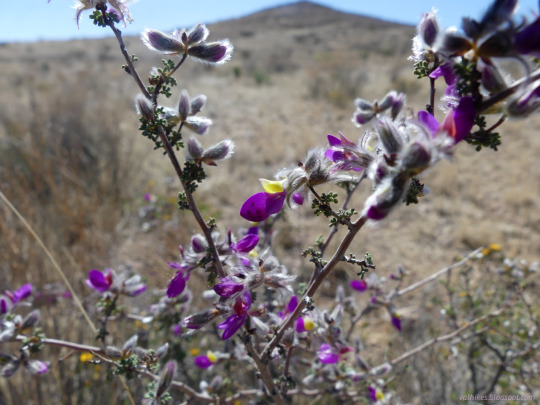



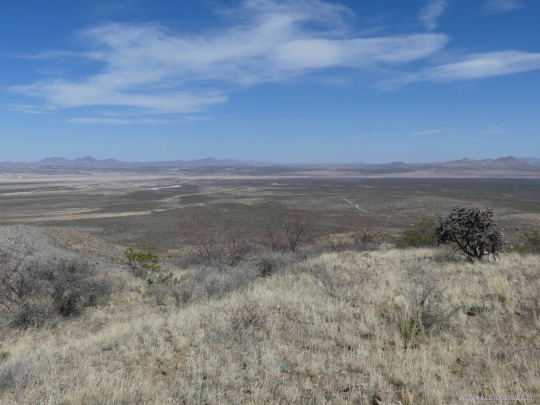


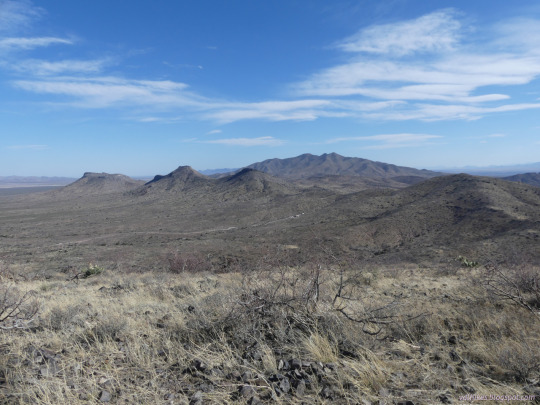
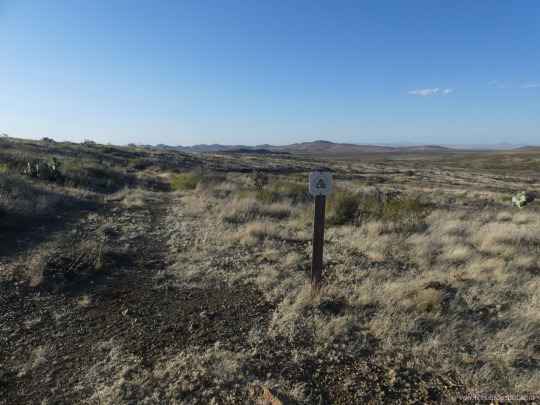

Las Cruces BLM, New Mexico.
Went along the CDT for a bit, then up and around a bunch of mountains. Accidentally found some old routes of the CDT. It's been moving around a bit. Found some little peaks too.
#day hike#hiking#New Mexico#Las Cruces BLM#nature#landscape#desert#peak#peakbagger#peak bagging#hike#outside#mountains#Little Hatchet Mountains#travel#loop hike#desert hiking#bootheel#New Mexico bootheel
2 notes
·
View notes
Text
Continental Divide Trail In Photos: New Mexico Bootheel
Continental Divide Trail In Photos: New Mexico Bootheel
Despite the Continental Divide Trail (CDT) having numerous starting (or ending, if you’re one of those weird southbound hikers) points, many people (myself included) consider Crazy Cook Monument to be the “official” southern terminus (probably because there’s a monument there with the CDT logo and an inscription that says “Southernmost Point”).
The Bootheel (that is, the southwestern corner of…
View On WordPress
0 notes
Photo

There isn’t much out by #AntelopeSprings, #NM, in the Bootheel except a few cows willing to pose for #Cow #ModelShoots! You’ll drive 48 miles to closed border crossing and #noservices and few free ranging cattle. That being said; there is something truly strange about this place! It feels like UFOs have traversed these basin and range valleys in this secluded part of New Mexico!? Dare I call it #UFOCountry? Well, I would take the risk to say YES since everyone and their cat & dog have claimed see #UFOs around the near ghost town of #Hacheta and even the townspeople were telling me stories about seeing #GreyAliens in the flesh, physically, on their ground around the area!!! (at Antelope Springs, New Mexico) https://www.instagram.com/p/CRmXBA0LMF9/?utm_medium=tumblr
4 notes
·
View notes
Text
Border patrol agent found dead while patrolling New Mexico trail
A first-year US Border Patrol agent was found dead while on patrol of a remote New Mexico trail, officials said. Border Patrol officials said Saturday that agent Johan Mordan, 26, was on duty when other agents lost communication with him in the desert of the New Mexico Bootheel, El Paso Times reported. Mordan, who joined […]
The post Border patrol agent found dead while patrolling New Mexico trail appeared first on Times Now Post.
source https://www.timesnowpost.com/border-patrol-agent-found-dead-while-patrolling-new-mexico-trail/?utm_source=rss&utm_medium=rss&utm_campaign=border-patrol-agent-found-dead-while-patrolling-new-mexico-trail
0 notes
Photo




Real Life in the Borderlands
Warner Glenn started the Malpai Borderlands Group twenty five years ago to bring together his fellow ranchers and land owners in Southern Arizona and the Bootheel of New Mexico and to improve communications with the various government agencies where relations were historically tense or completely broken.
Through Chris Van Dyke’s contacts in the outdoor and conservation worlds, we were invited to meet this group at their annual meeting that was held at the Malpai Ranch outside Douglas, Arizona that has been in the Glenn family for six generations. This meeting was a role mode for the kind of civic engagement that ought to be happening all across America but appears sadly lacking - the Glenns and their neighbors in two states, representatives from state government, BLM, National Forest Service, The Nature Conservancy, and other interested conservation groups all discussing issues of mutual interest with respect and constructive intent.
The Customs and Border Patrol chief from the Douglas area gave an update. We learned that apprehensions were few in this area (migrants and drug movements at an all time low) but that they were dealing with an overflow from El Paso where asylum-seeking families are turning themselves in to authorities in groups of several hundred at a time. The local CBP team in this area has been reduced from 600 to 400 as a result but they do have additional technology and people from military deployments to the border - the National Guard are not very useful but the regular army Military Police are appreciated. We also heard that they had entered into the planning stages for a 30 foot wall across this area and into New Mexico but the national focus was on Texas where the process could get bogged down in a huge humber of complex land ownership issues and lawsuits. Maybe the wall won’t happen here for years.
Maybe.
After the meeting, Kelly Kimbro, Warner’s daughter, took us for a short tour of the ranch where they keep a few hundred head of cattle and hunt mountain lions. While she took care of the well pump we had a wide-ranging frank discussion on the issues of the day. Kelly has welcomed politicians of all persuasions and is not shy in expressing her views. We asked Kelly and others at the meeting if they thought a wall was a solution to any problems on the border and they all responded with a resounding NO - “I don’t care what you build, people are still going to come through” and “anyone with the border as their property line wants a vehicle barrier and technology to help Border Patrol to do their job”. “Boy, I’d love to get Donald Trump into this truck to talk to him”.
A lot of people around here have put millions of dollars and decades of work into conservation with partners on both sides of the aisle and both sides of the border. The Sky Islands country is one of the most diverse habitats in America; a series of high valleys and mountains between the Rockies and the Sierra Madre where people have been limiting development to preserve its uniqueness. A wall through here would ruin all their efforts. An ecological disaster in the making.
Everyone we met today was extraordinarily generous with their time and willingness to answer questions and engage a group of strangers who showed up on motorcycles.
This is America how it should be.
Photos: Warner Glenn and his daughter Kelly Kimbro - driving across the ranch to manage the well pump and cattle trough - family museum with equipment and artifacts from generations of life on the ranch
1 note
·
View note